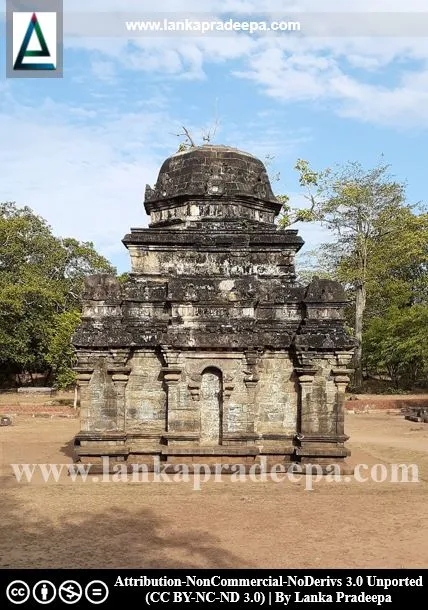
|
Polonnaruwa Siva Devale No. 2 |
Siva Devale No. 2, also known as Shiva Kovil No. 2 (Sinhala: පොළොන්නරුව ශිව දේවාලය අංක 2), is one of the Siva temples situated in the Ancient City of Polonnaruwa, Sri Lanka.
History
The Anuradhapura Kingdom of Sri Lanka was invaded in 993 A.D. by the South Indian King Rajaraja I (985-1014 A.D.) and his son, King Rajendra Chola I (1014-1044 A.D.) completed the conquest in 1017 A.D. by taking the control of the country. They chose Polonnaruwa as their administrative centre and ruled Sri Lanka from 1017 A.D. to 1070 A.D. until they were defeated and expelled by King Vijayabahu I (1055–1110 A.D.).
The impact of the Chola rule on Sri Lankan culture is clearly visible in the monumental and sculptural art of the Polonnaruwa Period. During this period, the Cholas built temples in Polonnaruwa for the worship of Hindu deities such as Siva, Vishnu, Ganesha and Kali.
Siva Devale No. 2
The Siva Devale No. 2 is considered the oldest Hindu shrine located in Polonnaruwa ancient city and was built by King Rajaraja I (Wikramagamage, 2004). According to a Tamil inscription found in situ, this Siva temple has been named after Vanavan Madevi (Vanavan Madevi Ishwaram), a consort of King Rajaraja I (Ray, 1960).
Inscriptions
Tamil Inscriptions
Three inscriptions written in Grantha Tamil characters are found on the outer walls of the Devalaya (Arunachalam, 2004). The earliest of these inscriptions has been dated to the reign of Rajendra Chola I (Pathmanathan, 1987).
The longest inscription found in this temple is dated in the reign of Parakesarivarman alias Udaiyar Sri Adhirajendra Deva [(1070 A.D.) Arunachalam, 2004; Pathmanathan, 1987]. It records an endowment (a lamp and five gold coins) made to the temple by a certain Chola Pallavaraiyan, a dignitary of high rank from Mankalappadi in Virpeddunadu (Pathmanathan, 1987). According to the inscription, the endowed lamp should be maintained from the interest on the money (five gold coins) deposited (Pathmanathan, 1987).
Sinhala Inscription
A rectangular stone pillar built into a foundation of a small ruined structure standing near Siva Devale No. 2 contains a Sinhala inscription belonging to the 10th century A.D. (Ranawella, 2004). The record has been dated in the twelfth regnal year of King Dappula IV [(924-935 A.D.) Ranawella, 2004].
The Temple
The temple is entirely built out of stones (mainly granite) and remains in a satisfactory state of preservation (Prematileke, 1990; Wikramagamage, 2004). The remaining architectural details indicate the same stage in their evolution as in South Indian temples from the Chola epoch (Ray, 1960).
The shrine mainly consists of the Garbhagrha (the sanctum) and the Antarala and Ardhamandapa (Prematileke, 1990). The Antarala which is facing to the east gives access to the Garbhagrha. The stone-cut Siva-linga, the main religious object of worship, is erected in the Garbhagrha (Wikramagamage, 2004). The roof is an octagonal-shaped dome and ends at a height of 31 ft 9 in. above the ground (Prematileke, 1990; Ray, 1960). The exterior walls of the shrine are decorated with ornate carvings and some of the stone slabs on the walls contain inscriptions written in Grantha Tamil characters. A broken figure of bull Nandi, the vehicle of God Siva is presently placed in front of the shrine building. Besides that, many Hindu sculptures have been found on this site.
Hindu religious rituals are performed here even at the present time (Wikramagamage, 2004).




Related Posts
Read Also
References
Books, Journal Articles
1) Arunachalam, P., 2004. Polonnaruwa bronzes and Siva worship and symbolism. Asian Educational Services. pp.3-4.
2) Pathmanathan, S., 1987. Hinduism in Sri Lanka (Circa AD 1000-1250): Indian Influences on the Development of Saivism. p.53.
3) Prematilleke, L., 1990. The architecture of the Polonnaruwa Period B.C. 800 - 1200 A.D. [Wijesekara, N. (Editor in chief)]. Archaeological Department centenary (1890-1990): Commemorative series: Volume III: Architecture. Department of Archaeology (Sri Lanka). p.56.
4) Ranawella, G.S., 2004. Inscription of Ceylon: Containing pillar inscriptions and slab inscriptions from 924 AD to 1017. Volume V, Part II. Department of Archaeology. ISBN: 955-9159-30-5. pp.113-115.
5) Ray, H. C. (Editor in Chief), 1960. University of Ceylon: History of Ceylon (Vol 1, part II). Ceylon University Press. p.590.
6) Wikramagamage, C., 2004. Heritage of Rajarata: Major natural, cultural and historic sites. Colombo. Central Bank of Sri Lanka. p.213.
Location Map
Dynamic Google Map
පොළොන්නරුව ශිව දේවාලය අංක 2
පොළොන්නරුව ශිව දේවාලය අංක 2 ශ්රී ලංකාවේ පුරාණ පොළොන්නරු නගරයේ පිහිටි හින්දු දේවාලයකි.
ඉතිහාසය
ශ්රී ලංකාවේ අනුරාධපුර රාජධානිය ක්රි.ව. 993දී දකුණු ඉන්දියානු රජෙකු වූ පළමුවන රාජරාජ (ක්රි.ව. 985-1014) විසින් ආක්රමණය කරනු ලැබූ අතර ඔහුගේ පුත් රාජේන්ද්ර චෝල රජු (ක්රි.ව. 1014-1044) වර්ෂ 1017 වන විටදී දිවයිනෙහි රාජ්ය පාලනය සිය යටතට ලබා ගැනීමට සමත්ව තිබුණි. සිය පරිපාලන කේන්ද්රය වශයෙන් පොළොන්නරුව තෝරාගත් ඔවුහූ, පළමුවන විජයබාහු රජු විසින් පරජය කර මෙරටින් පලවා හරින තුරු, එනම් ක්රි.ව. 1017 සිට 1070 දක්වා ශ්රී ලංකාවේ රාජ්ය පාලන කටයුතුවල නිරත විය.
ශ්රි ලාංකික සංස්කෘතිය කෙරෙහි වූ චෝල පාලනයෙහි බලපෑම පොළොන්නරු යුගයෙහි ස්මාරකයන්හී පැහැදිලිව දෘශ්යමාන වේ. මෙම සමයෙහිදී චෝලයන් විසින් ශිව, විශ්ණු, ගණේෂ, හා කාලි වැනි හින්දු දෙවිවරුන් උදෙසා දේවාල ඉදිකරන ලදී.
ශිව දේවාලය අංක 2
පළමුවන රාජරාජ රජු විසින් ඉදිකරනු ලැබූ අංක 2 ශිව දේවාලය පුරාණ පොළොන්නරු නගරයේ පිහිටි පැරණිතම හින්දු පුදබිම වේ. මෙහි තිබී හමුවූ දෙමළ සෙල්ලිපියකට අනූව මෙම ශිව දේවාලය පළමුවන රාජරාජ රජුගේ මෙහෙසියක වූ වනවන් මාදේවිගේ නමින් නම් කොට තිබේ.
දේවාලය
සම්පූර්ණ ගලෙන් නිමවා තිබෙන දේවාලය ගර්භගෘහය, අන්තරාලය, හා අර්ධමණ්ඩපය යන ප්රධාන කොටස් තුනකින් සමන්විත වේ. නැගෙනහිර දිශාවට මුහුණලා තිබෙන අන්තරාලය, ගර්භගෘහය වෙත ප්රවිශ්ඨය ලබා දෙයි. වන්දනාමානයට පාත්ර ගලින් නෙළා ඇති ශිව ලිංගය ගර්භගෘහය තුල පිහිටුවා ඇත. අශ්ඨාකාර හැඩැති දේවාලයෙහි වහලය බිම් මට්ටමෙහි සිට අඩි 31 ක් පමණ උසින් පිහිටයි. දේවාලයෙහි පිටත බිත්ති අලංකාර කැටයම් වලින් යුක්ත වන අතර එහි අල්ලා ඇති සමහර ගල් පුවරු මත දෙමළ ග්රන්ථාක්ශරයෙන් රචිත සෙල්ලිපි වෙයි.



